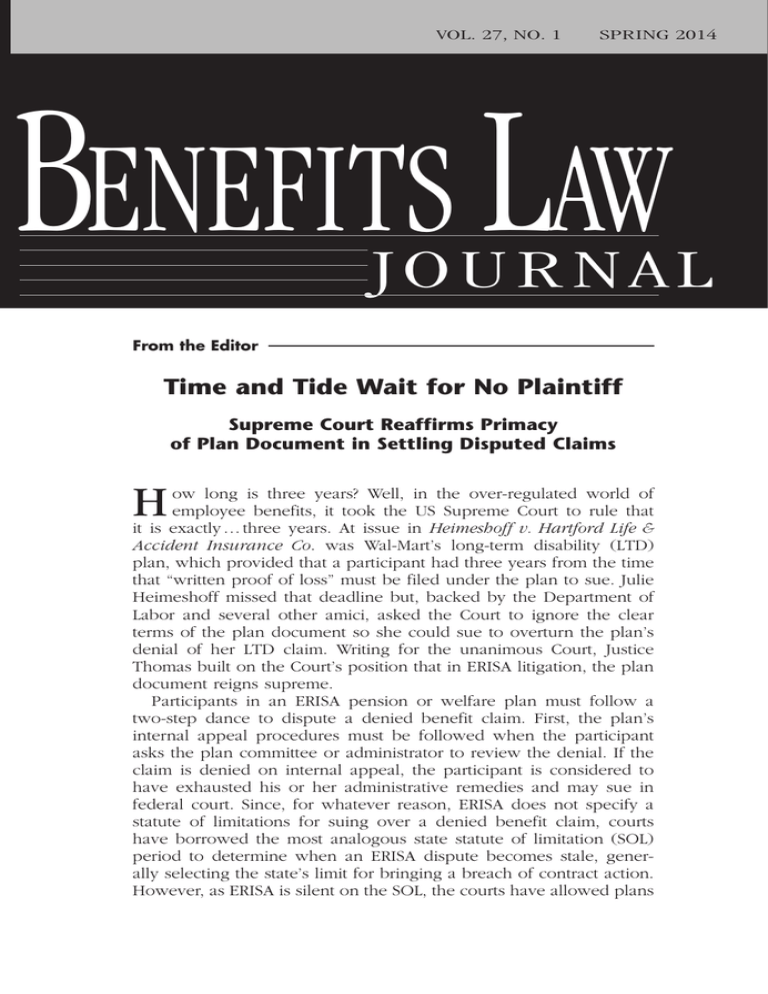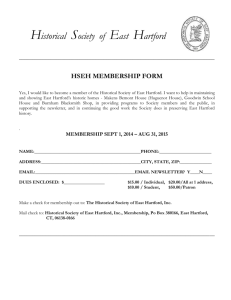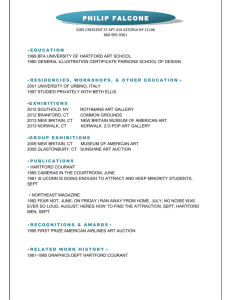
VOL. 27, NO. 1
SPRING 2014
BENEFITS LAW
JOURNAL
From the Editor
Time and Tide Wait for No Plaintiff
Supreme Court Reaffirms Primacy
of Plan Document in Settling Disputed Claims
H
ow long is three years? Well, in the over-regulated world of
employee benefits, it took the US Supreme Court to rule that
it is exactly … three years. At issue in Heimeshoff v. Hartford Life &
Accident Insurance Co. was Wal-Mart’s long-term disability (LTD)
plan, which provided that a participant had three years from the time
that “written proof of loss” must be filed under the plan to sue. Julie
Heimeshoff missed that deadline but, backed by the Department of
Labor and several other amici, asked the Court to ignore the clear
terms of the plan document so she could sue to overturn the plan’s
denial of her LTD claim. Writing for the unanimous Court, Justice
Thomas built on the Court’s position that in ERISA litigation, the plan
document reigns supreme.
Participants in an ERISA pension or welfare plan must follow a
two-step dance to dispute a denied benefit claim. First, the plan’s
internal appeal procedures must be followed when the participant
asks the plan committee or administrator to review the denial. If the
claim is denied on internal appeal, the participant is considered to
have exhausted his or her administrative remedies and may sue in
federal court. Since, for whatever reason, ERISA does not specify a
statute of limitations for suing over a denied benefit claim, courts
have borrowed the most analogous state statute of limitation (SOL)
period to determine when an ERISA dispute becomes stale, generally selecting the state’s limit for bringing a breach of contract action.
However, as ERISA is silent on the SOL, the courts have allowed plans
From the Editor
to substitute their own time limit for participants to sue rather than
rely on state law, provided the plan-set limit was reasonable.
Although it was well-settled that plans may specify an SOL, there
was a dispute between the circuits whether employers could also
specify when the clock begins to tick. That question brought the
Hartford case to the Supreme Court.
Julie Heimeshoff, a senior PR manager for Wal-Mart, began to experience chronic pain, fatigue, and other maladies that were eventually
diagnosed as lupus and fibromyalgia. On August 22, 2005, Heimeshoff
filed a claim for LTD benefits with Hartford, Wal-Mart’s LTD plan
administrator. Hartford denied the claim in November because one
of Heimeshoff’s doctors had not provided the requested reports, but
gave her extra time to complete the file. Heimeshoff got a new doctor
who reported, in July 2006, that she was disabled. Hartford then hired
its own MD, who concluded in November that Heimeshoff could do
sedentary work. At that time, Hartford denied Heimeshoff’s claim.
She then asked for, and received, extra time to file an appeal and
provided additional medical evaluation in September 2007. Hartford
had more doctors look at the reports and finally denied the claim on
November 26, 2007. On November 18, 2010, Heimeshoff sued.
The LTD plan’s a three-year statute of limitations stated: “Legal
action cannot be taken against The Hartford [more than] three years
after the time written proof of loss is required to be furnished” under
the plan. Under the most generous reading, written proof of loss—
meaning the documents, reports, applications, etc.—showing that
Julie was disabled, was due on September 30, 2007. In that case,
Heimeshoff had to sue by September 30, 2010, and her November 18,
2010, complaint was filed about a month and a half late. Wal-Mart and
Hartford moved to have the suit dismissed as time-barred. The district
court and the US Court of Appeals for the Second Circuit agreed.
Given that the courts allow employers to choose the limitations
period, it is somewhat perplexing that some courts were unwilling to allow employers to select when the SOL clock begins to run.
Otherwise, if the starting line could be moved by a sympathetic judge
wishing to extend the limit for an otherwise late participant, the
authority to set the SOL would be illusory. That’s exactly what the
unanimous Supreme Court ruled. Drawing on pre-ERISA principles of
contract law, Justice Thomas noted that, in the absence of a controlling statute, parties to a contract are free to set their own limitations
period as long as they are “reasonable.” According to the Supreme
Court, that a plan’s SOL ordinarily should be enforced as written is
especially appropriate when enforcing an ERISA plan. Then, quoting
its recent decision in US Airways, Inc. v. McCutchen, the Court reiterated “‘[t]he plan, in short, is at the center of ERISA.’”
BENEFITS LAW JOURNAL
2
VOL. 27, NO. 1, SPRING 2014
From the Editor
In advocating for the plaintiff, what got the Department of Labor’s
dander up was the fear that unscrupulous employers could keep a
participant from his or her day in court by foot-dragging during an
internal appeal or creating other obstacles during the claim process.
The Court brushed these objections away with a feather, noting that
the time limit must be reasonable, and a court can impose tolling or
other equitable remedies if the participant was not given enough time
to sue. The facts in Hartford hardly show a Machiavellian attempt to
deny Heimeshoff a fair chance. Twice, it appears, Hartford gave her
extra time during the claim process: once when she switched doctors
and then again after she asked Hartford for extra time. Even then,
Heimeshoff had almost a full year after the final denial to bring suit.
She simply didn’t act until it was too late.
Happily for employers wishing to offer their employees costeffective benefits without spending their days in court ligating over
those benefits, Hartford continues the Supreme Court’s commonsense approach that thou shalt enforce the plan document as written.
Perhaps even the DOL will understand this point and stop wasting its
valuable resources on a world view that lets courts and bureaucrats
decide what’s best for all. The DOL should recognize that certainty
and ease of administration will encourage employers to offer benefits,
while more rules and hurdles only serve to discourage them.
For employers, the “take away” is to review their plans and consider adding a reasonable SOL, including a clear statement of when
the clock starts. Perhaps, to avoid disputes with retirees years after a
benefit accrued (I worked full time in July 1997), with some retirement plans employers may wish to start the clock running with the
distribution of an annual benefit statement. Employers also should
consider a “blue pencil” clause providing that if a district court finds
the plan’s SOL too restrictive, it should expand it only as necessary
to make it enforceable. Bottom line: employers, you own your plan
documents; write them as you wish them to be read.
David E. Morse
Editor-in-Chief
K & L Gates LLP
New York, NY
BENEFITS LAW JOURNAL
3
VOL. 27, NO. 1, SPRING 2014
Copyright © 2014 CCH Incorporated. All Rights Reserved.
Reprinted from Benefits Law Journal Spring 2014, Volume 27,
Number 1, pages 1–3, with permission from Aspen Publishers,
Wolters Kluwer Law & Business, New York, NY, 1-800-638-8437,
www.aspenpublishers.com




